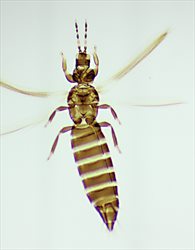
Female

Antenna
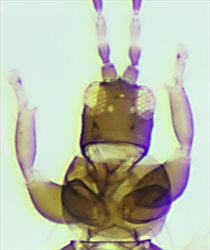
Head, pronotum & fore legs
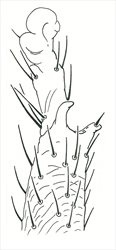
Fore tibia & tarsus
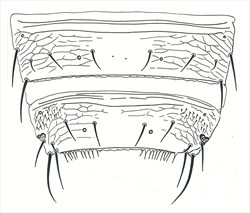
Female tergites VII-VIII
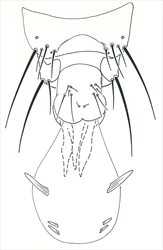
Male tergite IX & genitalia
Both sexes fully winged. Body and legs dark brown, mid and hind tarsi paler, fore tarsi and parts of fore tibiae yellow; antennal segment III brownish yellow, IV–VIII uniformly brown; fore wings brown with sub-basal white band. Antennae 8-segmented; segments III–IV constricted to apex, with forked sense cone; segment VI sense cone with enlarged oval base; dorsal apex of segment I with pair of setae. Head wider than long; three pairs of ocellar setae present, pair III longer than distance between compound eyes, arising on anterior margins of ocellar triangle; maxillary palps 3-segmented. Pronotum with a few sculpture lines medially, about 10 discal setae and two pairs of long posteroangular setae. Fore tarsus distal segment with no small tubercles; fore tibia apex with two prominent re-curved claws ventrally and laterally. Mesonotum with paired anterior campaniform sensilla, median setae close to posterior margin. Metanotum reticulate; median setae long, arising at anterior margin; campaniform sensilla present. Fore wing first vein with setal row almost complete but with small sub-apical gap; setal row complete on second vein, usually with more than 20 setae. Abdominal tergites with no ctenidia, median setal pair small and wide apart, II–VIII with no sculpture lines across median area; tergite VIII with posteromarginal comb with slender microtrichia laterally but none on median third, with group of microtrichia anterolateral to spiracle; IX with 2 pairs of campaniform sensilla, X with median split. Sternites without discal setae, S1 on VII arising in front of margin.
Male smaller than female; tergite IX without a pair of stout dark tooth-like processes posterolaterally; sternites without pore plates; extruded genitalia bearing 3 or 4 spines with the basal ones larger than the distal pair.
The genus Odontothrips currently includes 33 species. All but two of these are from the Holarctic region, including Iran and China, but one species is described from Rajasthan, India, and another from Guinea. From Europe, 19 species of Odontothrips are recorded (zur Strassen, 2003), with eight from Britain. Almost all Odontothrips species breed only in the flowers of Fabaceae (Pitkin, 1972). Although generally similar to loti in colour and structure, ulicis is particularly similar to the specialist on broom, cytisi, in having the fore tibiae each with two stout recurved claws, but the males differ in the form of tergite IX and the size of the basal pair of endothecal spines on the male genitalia.
Feeding and breeding in flowers and pupating at ground level, and apparently specific to Ulex europaeus [Fabaceae]. In Britain, it is replaced on other species of Ulex by O. ignobilis.
In Britain known from Kent to Caithness, but has not been recorded from the English Midlands or Wales despite its relative visibility on gorse flowers. This may be a case of under-recording as targeted investigation in Yorkshire, another area where it had not previously been recorded, showed it to be common across the county (Collins, 2006). Also known from the Channel Islands and Northern Ireland as well as the Republic of Ireland (Mound et al., 1976), and recorded widely across Western Europe and Scandinavia (zur Strassen, 2003).
THRIPIDAE - THRIPINAE
Odontothrips ulicis (Haliday)
Thrips ulicis Haliday, 1836: 446
Collins DW (2006) Odontothrips confusus Priesner (Thysanoptera: Thripidae) new to Britain and recent records of other British thrips. British Journal of Entomology and Natural History. 19: 145–156.
Mound LA, Morison GD, Pitkin BR & Palmer JM (1976) Thysanoptera. Handbooks for the Identification of British Insects 1 (11): 1–79.
Pitkin BR (1972) A revision of the flower-living genus Odontothrips Amyot & Serville. Bulletin of the British Museum (Natural History) (Entomology) 26: 371–402.
zur Strassen R (2003) Die terebranten Thysanopteren Europas und des Mittelmeer-Gebietes. Die Tierwelt Deutschlands 74: 1–271.